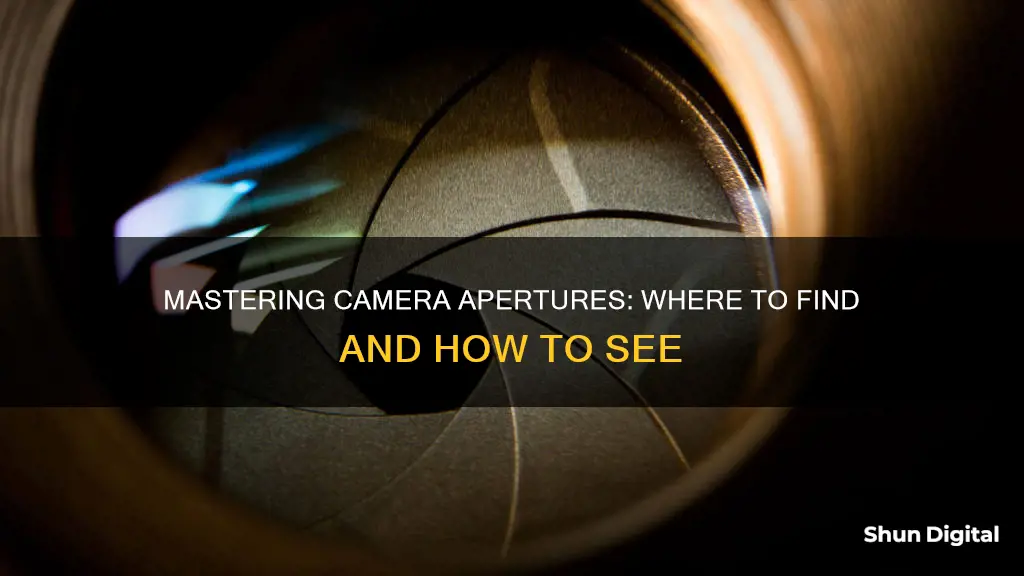
Aperture is one of the three pillars of photography, alongside shutter speed and ISO, and it's crucial to understanding how to take great photographs. In simple terms, aperture refers to the size of the opening in your camera lens that lets light in. Aperture is usually expressed in f-stops, with lower f-stop numbers indicating a more open aperture and higher numbers indicating a smaller opening. By adjusting the aperture, you control how much light enters your camera and hits the image sensor, which is similar to how the pupil in your eye adjusts to let in more or less light depending on the lighting conditions.
Aperture not only affects the exposure of your photos but also the depth of field. A larger aperture creates a shallow depth of field, resulting in a blurred background, which is often used in portrait photography. On the other hand, a smaller aperture yields a wider depth of field, keeping both the foreground and background in sharp focus, which is ideal for landscape photography.
While aperture is controlled by your camera, it is actually located inside your lens. Different lenses have different aperture capabilities, and this information is usually noted by the f-stop number range on the side of the lens.
| Characteristics | Values |
|---|---|
| What is aperture? | The size of the opening in the lens through which light passes. |
| Where is aperture located? | Inside the lens. |
| How does aperture work? | Aperture controls the amount of light that enters the camera and hits the image sensor. |
| How is aperture measured? | Aperture is measured in number increments called f-stops. |
| What is the impact of aperture on exposure? | Aperture, along with ISO and shutter speed, impacts how well a photo is exposed. |
| What is the impact of aperture on depth of field? | Aperture controls the depth of field in a photograph. A larger aperture results in a shallower depth of field, while a smaller aperture results in a wider depth of field. |
| What is the impact of aperture on shutter speed? | Aperture size determines the shutter speed needed to achieve the correct exposure. A small aperture requires a longer shutter speed, while a large aperture requires a shorter shutter speed. |
| What is the impact of aperture on ISO? | Aperture size determines the ISO needed to achieve the correct exposure. A small aperture requires a lower ISO setting, while a large aperture requires a higher ISO setting. |
| What is the impact of aperture on lens size? | Aperture size determines the minimum focus distance of the lens. |
| What is the impact of aperture on diffraction? | Aperture size determines the amount of diffraction that occurs. A small aperture causes more diffraction, while a large aperture causes less diffraction. |
| How do I adjust aperture on a DSLR camera? | On a DSLR camera, adjusting the aperture involves turning a dial to change the size of the opening in the lens. |
| What is aperture priority mode? | Aperture priority mode allows the user to select the aperture while the camera sets an appropriate shutter speed. |
What You'll Learn

Aperture is the physical size of the hole inside your lens
Aperture is measured in number increments called f-stops. Each f-stop or "f" number indicates how small or large the hole is. The higher the f-stop or "f" number, the smaller the hole, and the lower the f-stop, the larger the hole. This is where people often get confused because the smaller the number, the bigger the hole and vice versa. For example, a small f-stop like f/2.8 means a big hole, while a higher f-stop of f/16 means a much smaller hole.
The aperture size affects the amount of light that passes through the lens and reaches the camera sensor, thereby affecting the brightness or exposure of your images. A large aperture (a wide opening) will pass a lot of light, resulting in a brighter photograph. On the other hand, a small aperture does the opposite, making the photo darker.
Aperture also affects the depth of field in your photographs. A large aperture will give you a blurred background with a beautiful shallow focus effect, which is popular for portrait photography. A small aperture will give you sharp photos from the nearby foreground to the distant horizon, which is often used in landscape photography.
By understanding and manipulating aperture, you can control the amount of light entering your camera and achieve the desired exposure and depth of field for your images.
Target's Camera Surveillance: Who's Watching?
You may want to see also

Aperture is controlled by the photographer, not the camera
Aperture is the opening in a lens that lets light pass through to enter the camera. The photographer controls the aperture using the camera, except in the case of old lenses, which are manually controlled. The size of the aperture can be changed, and this is measured in f-stops. The higher the f-stop, the smaller the aperture, and the less light will enter the camera. Conversely, a lower f-stop means a larger aperture and more light entering the camera.
Aperture is one of the most important elements of photography, alongside shutter speed and ISO. It is a key way to add dimension to your photos by controlling the depth of field. A large aperture will give a blurred background with a shallow focus effect, which is popular for portrait photography. A small aperture will give a sharper image, often used in landscape photography.
The aperture also controls the brightness of your images. A large aperture will result in a brighter photograph, while a small aperture will make the image darker.
The photographer can manually select their desired aperture using either aperture-priority mode or manual mode. In aperture-priority mode, the camera will automatically select the shutter speed, and the photographer can choose whether to select the ISO manually or automatically. In manual mode, the photographer selects both the aperture and shutter speed manually, which takes more time but gives the photographer more control.
The photographer should also consider the minimum and maximum aperture of their lens. The maximum aperture is usually the most important as it tells you how much light the lens can gather. A lens with a larger maximum aperture is considered a "fast" lens and will be more expensive.
Understanding TV Cameras: Locating the Iris
You may want to see also

Aperture is measured in f-stops
Aperture is the physical size of the hole inside your camera lens. The size of this hole can be changed, and this is measured in f-stops. The higher the f-stop or "f number", the smaller the hole, and the lower the f-stop, the larger the hole.
The aperture controls the amount of light that enters the camera lens, and it's measured in f-stops. The "f" in f-stop stands for the focal length of the lens. The aperture is the hole in the middle of the lens, made up of rotating blades that open to let in light when you press the shutter release. The diameter of the aperture determines how much light gets through and, thus, how bright your exposure will be.
The f-stop is expressed as a fraction, with "f" as the numerator and the f-stop number as the denominator. The aperture size reads inversely to its corresponding f-number: the smaller the f-number, the larger the aperture. The larger the f-number, the smaller the aperture.
The range of f-stops you can shoot with depends entirely on your camera lens. The lowest f-stop your lens can shoot with is called the maximum aperture. Many zoom lenses have a maximum aperture of f/2.8 or f/4, and some have a variable range. A prime lens, or a lens with a fixed focal length, can handle a wider aperture because it contains fewer moving parts.
LG 65UK6300PUE TV: Is There a Camera?
You may want to see also

A larger aperture lets in more light
Aperture is the opening in a lens through which light passes to enter the camera. The size of the aperture can be changed, and this is controlled by the photographer. A larger aperture lets in more light, resulting in a brighter photograph.
The aperture is measured in f-stops, which are numbers that indicate how small or large the hole is. A lower f-stop denotes a larger aperture, which lets in more light. For example, f/2.8 is a larger aperture than f/4.
The aperture also affects the depth of field in a photograph. A larger aperture will result in a blurred background with a shallow focus effect, often used in portrait photography. On the other hand, a smaller aperture will result in sharper photos with a wider depth of field, often used in landscape photography.
The aperture also plays a crucial role in low-light photography. A larger aperture, such as f/1.4 or f/1.8, is considered a "fast" lens as it can pass through more light. This is ideal for low-light conditions, allowing you to capture more light and create a shallow focus effect.
The size of the aperture also impacts the quality of the background blur, known as bokeh. A larger aperture will result in a rounder background blur, while a smaller aperture may result in different shapes depending on the lens.
In summary, a larger aperture lets in more light, making your photographs brighter. It also affects the depth of field, the amount of light in low-light conditions, and the quality of the background blur. By adjusting the aperture, photographers can create various effects and ensure they capture the desired amount of light in their photographs.
Cameras Behind the Scenes of End of Watch
You may want to see also

Aperture controls the depth of field in your photograph
Aperture is the opening in your lens that lets light pass through to the sensor. Think of it as a pupil for your lens. It dilates to let more light in and contracts to restrict light when it is bright. Aperture is the first thing most photographers think of when they want to adjust the depth of field.
Aperture is one of the three pillars of photography, the other two being shutter speed and ISO. Of the three, aperture is the most important. Aperture can be defined as the opening in a lens through which light passes to enter the camera. It is an easy concept to understand if you think about how your eyes work. As you move between bright and dark environments, the iris in your eyes either expands or shrinks, controlling the size of your pupil.
The aperture you choose also alters the exposure of your images by making them brighter or darker. A large aperture (a wide opening) will pass a lot of light, resulting in a brighter photograph. A small aperture does the opposite, making a photo darker.
Aperture is like the "pupil" for your camera system, which can open and close to change the amount of light that passes through. Aperture can add dimension to your photos by controlling depth of field. At one extreme, aperture gives you a blurred background with a beautiful shallow focus effect. This is very popular for portrait photography.
At the other extreme, it will give you sharp photos from the nearby foreground to the distant horizon. Landscape photographers use this effect a lot.
Aperture is measured in number increments called f-stops. Each f-stop or "f" number indicates how small or large the hole is. The higher the f-stop or "f" number, the smaller the hole. The lower the f-stop or "f" number, the larger the hole.
The larger the aperture, the more light is recorded and the shallower the depth of field. With smaller apertures, less light is recorded and the depth of field is greater. Aperture is recorded in f-stops and is shown by the symbol "f".
Depth of field is the sharpness range either side of a focus point. This is controlled by the aperture. Larger apertures (smaller f-stop numbers) result in a shallower depth of field, where less is sharp. Smaller apertures (higher f-stop numbers) result in a greater depth of field, where more is sharp.
There are three different factors that influence depth of field: aperture, distance from your subject, and magnification.
Amazon Fire TV: Camera Included or Not?
You may want to see also
Frequently asked questions
Aperture is not inside your camera, it's inside your lens. You can control your aperture with your camera. You can see the aperture by looking at the f-stop number on your camera.
Aperture is the physical size of the hole inside your lens. The f-stop is the size of the aperture opening in relation to the focal length/aperture size for that specific lens.
To change the aperture on your camera, you need to put your camera in manual mode. Then, hold down the button that controls the aperture (this will depend on your camera model) and turn the control dial to adjust the aperture.







